CalIT2 Workshop Looks to the Future of Health and Medicine
Story by:
Published Date
Article Content
On October 10, the Qualcomm Institute (QI) at UC San Diego hosted the CalIT2 Workshop on Health and Research Innovations, bringing together leading professionals, researchers, and academics to explore the latest advances in healthcare, mental health and medical research.
“[This workshop] is an opportunity to get stimulated in the ways in which we can address the challenges that await us,” said QI Director Ramesh Rao, who is also interim director of the California Institute for Telecommunications and Information Technology (CalIT2), a collaboration of UC San Diego, UC Irvine (UCI) and UC Riverside (UCR).
Throughout the day-long event, participants from all three campuses engaged on current issues in health and medicine. Plenary talks presented fresh perspectives on topics from addiction to hospital cybersecurity. Lighting talk sessions tackled sepsis, brain imaging, and generative AI for healthcare. Finally, an open house showcased cutting-edge research facilities and innovative startups in QI’s Atkinson Hall.
Toward healthy aging
Alison Moore, M.D., professor, director of the Stein Institute on Aging and chief of the Division of Geriatrics, Gerontology and Palliative Care at the UC San Diego School of Medicine, opened the plenary talks with “Diverse Approaches to Support Healthy Aging.” She emphasized that the widespread interest in aging by companies, non-profits and government agencies is spurred by the numbers — 12.4 percent of the U.S. population was 65 and older in 2000; in 2022, only two years later, that percentage had risen to 17.3.
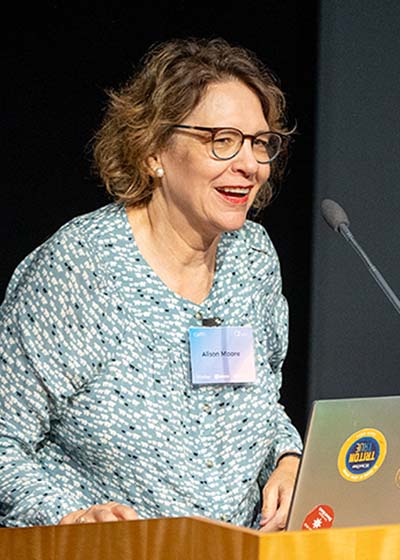
Moore noted that being free of disease or infirmity is not a requirement for healthy aging, but key factors do include physical activity, cognitive engagement, social interaction and managing stress and chronic conditions. Other factors that contribute to how we age include genetics, diet and medical care.
“Healthy aging looks different for everyone,” she said. “We know this as we think about those in our lives who are aging. It's multifactorial; that is, there are a wide variety of factors that influence our wellbeing.”
Moore highlighted a number of ongoing initiatives that promote healthy aging. In addition to those from the State, County and City, she called out local nonprofits San Diego Oasis, Jewish Family Services, George G. Glenner Alzheimer’s Family Centers, Southern Caregiver Resource Center, Alzheimer’s San Diego, Elderhelp and the low-income-focused organization Serving Seniors. The Stein Institute for Research on Aging and Center for Healthy Aging, which Moore directs, also conducts research, training and community engagement.
Research to inform prevention and intervention in addiction
Sandra Brown, Ph.D., distinguished professor of psychology and psychiatry at UC San Diego, spoke on “Addiction: Promise for Prevention and Health Care Interventions.” Like aging, the statistics on addiction underline its relevance: 49 million Americans have addictive disorders, costing the country over $36 billion annually. Brown noted the disorder’s prevalence means that almost everyone knows someone with a substance use problem.
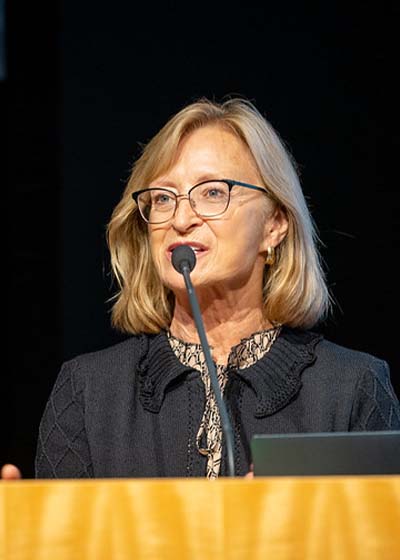
Large-scale longitudinal studies, such as the National Consortium on Alcohol and Neurodevelopment of Adolescents (NCANDA) and the Adolescent Brain Cognitive Development (ABCD) Study — both of which Brown co-leads — are particularly helpful in producing research to guide prevention and intervention in this area.
One finding has been that people who start to drink before age 15 are three and a half times more likely to develop an alcohol or drug use disorder in their lifetime. Notably, black and low-income families are more likely to have rules against their children using substances, helping to delay use and reduce the chance of addiction. These studies are identifying the subtle ways in which early use of alcohol and drugs affects adolescent brain development. These comprehensive developmental studies have also shown that adolescents who engage in two hours or more a day of screen time have accelerated risks for a variety of health and mental health problems, including addiction.
Brown noted the NCANDA and ABCD studies augment their impact through open science, in which data is available to other researchers and the public: “The thing about open science is that it can shrink the time from when we learn something to when we might be able to use it in prevention and intervention.”
The promise of personalized health
Ramesh Jain, Ph.D., professor emeritus of computer science and founding director of the UCI Institute for Future Health, spoke on “Personalized Health: The Next Frontier in Healthcare.”
Jain hopes that personalized health care can solve some of the most vexing problems in medicine and health care today. According to Jain, decisions about health tend to be framed as a choice between quality and quantity of life — “adding life to years” or “adding years to life” — but attention needs to be paid to both. New technologies, such as wearable devices, could help pave the way for a new health care model that focuses on both quality and quantity through active monitoring of the body to flag deviations from its normal steady state, known as homeostasis.
“Homeostasis is nature’s engineering mechanism, particularly when it comes to health,” Jain said. “We have to start focusing on continuous measurement and self-correction to empower individuals to take action.”
Jain is optimistic about the prospect of using AI and machine learning to develop interfaces to guide personalized health care. However, challenges surrounding data sources, application areas, and patient trust remain. “How do we buy health insights from different sources, from different knowledge?” he mused. “How do we provide this at the right time to be built at the right place, in the right situation, in an actionable form? And how do we make it so that people can trust it, and they are sure about what they are going to do?”
Cybersecurity for health care
Protecting patient data and ensuring the integrity of digital health care systems was the topic of a presentation given by the co-directors of the UC San Diego Center for Healthcare Cybersecurity. Christian Dameff, M.D., assistant clinical professor of emergency medical services at UC San Diego School of Medicine, and Jeffrey Tully, M.D., an associate clinical professor of anesthesiology at UC San Diego School of Medicine are working to address some of the vulnerabilities that have grown with wireless and digital health care technologies.
“We are clinicians first, but we're also cybersecurity researchers working in computer science, and we are really interested in understanding how cybersecurity interacts with the care that we deliver to our patients,” said Tully. “Not only is it important to protect our patient information and data, but it's also important to ensure that the tools and technologies we use to take care of patients in the clinic and in the hospital are available and not disrupted by things like ransomware attacks.”
As a case in point, Tully noted their team conducted a study of the month-long 2021 Scripps Hospital ransomware attack, showing that the effects of this event rippled across the region as patients were diverted to other medical centers. In another study, the group found that if you have a cardiac arrest in an area having a ransomware attack, your chance of survival goes down tenfold.
The Center for Healthcare Cybersecurity approaches these types of threats with three main goals in mind: rapidly identifying affected hospitals, improving clinical response during disruptions, and quickly restoring technical functions.
Research efforts at the center have made progress on all three fronts. Dameff and Tully reported that a system they developed to recognize abnormalities in the typical digital signature of a hospital was able to detect a ransomware attack in Chicago six hours before the hospital made any kind of statement. To improve clinical care during disruptions, Dameff and Tully’s team has run clinical simulations and is putting together a detailed playbook that can guide different types of clinical staff in a cybersecurity emergency. In addition, the team is developing a "crash cart" system independent of any one medical center’s technology that could be available to help restore hospital operations quickly to minimize the impact on patient care.
Putting the public back in public health
John W. Ayers, Ph.D., who is at UC San Diego as deputy director of informatics at the Altman Clinical and Translational Research Institute, vice chief of innovation in the Division of Infectious Disease and Global Public Health of the School of Medicine, and QI affiliate, was up next. In “Getting the Public Back in Public Health,” Ayers stated academic research can be dramatically out of step with what is going on in society, interfering with public health’s promise to save lives.

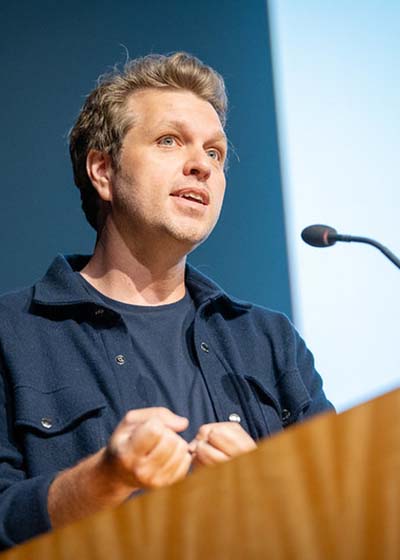
“What I want to do today is try to help you … reject this top-down driven model where we know the problems, we know the answers,” said Ayers. “What I want to do instead is spend more time listening to the public and responding to those needs and listen to where they are already sharing their voice, out in the wild, on the internet.”
As an example of how this can play out, he told the story of watching an episode of 60 Minutes in 2010 that described an epidemic in the use of snus, a flavored tobacco product. Never having heard of snus before, he looked at NIH RePORTER and found a number of ongoing academic studies on the phenomenon. However, when he examined Google search data, he saw interest in snus steadily dropping, but searches for another product — electronic nicotine delivery systems, now called e-cigarettes, taking off. In fact, the search data indicated 30 times more interest in e-cigarettes than snus. Ayers’ paper on the rising popularity of e-cigarettes was initially rejected by skeptical journal editors, but the paper was eventually published and went on to be one of the most popular studies that year in medicine.
In addition to offering a timely glimpse of possible public health threats, Ayers noted that digital data can be harnessed to bring about real-life positive outcomes. When actor Charlie Sheen disclosed his HIV-positive status on the Today Show in 2015, Ayers and team found that searches for HIV — including prevention and testing — surged. To further leverage this effect, Ayers suggested making condom commercials, like one featuring Sheen. In addition, the team’s initial research article on the Charlie Sheen effect itself increased searches related to HIV prevention and testing.
Unfortunately, media events can also have negative public health effects. When 13 Reasons Why debuted on Netflix, Ayers found suicide-related searches jumped. His efforts to have a warning label added to the show were frustratingly slow, but eventually succeeded. Some two years later, more traditional research detailing emergency room visits corroborated his findings that self-injuries rose in lock step with the show.
Exploring possibilities in Lithium Valley

The three CalIT2 directors — Rao; G.P. Li, Ph.D., director of CalIT UCI; and Shane Cybart, Ph.D., director of CalIT UCR — hosted the last plenary talk of the day. The session, which included a recorded message from Glenn Healey, Ph.D., UCI professor of electrical engineering and computer science, was themed around “Exploring New Collaborations: Addressing the Environmental and Public Health Crisis in Lithium Valley.”
Cybart described a project funded by the U.S. Economic Development Administration that highlights CalIT2’s strength as a consortium. The research targets an area around the Salton Sea, a body of water in Imperial Valley that was originally created by a disaster involving flooding of the Colorado River. The Salton Sea is now known for its high salinity, pollution with agricultural chemicals, toxic dust and, more recently, lithium deposits that can be extracted to make batteries for electric vehicles.
As part of the grant, UCR CalIT2 is leading the charge to study the problems and potential of job creation in this region, dubbed “Lithium Valley.” Building on years of work at UC campuses (including by the High Performance Wireless Research and Education Network, ALERTCalifornia and UC-originated CENIC), as well as investments by the State of California, the CalIT2 directors believe the consortium is in a unique position to help address issues in the region. “We think that we can use some of these same technologies that have already been developed by CalIT2 for fire monitoring to do lithium monitoring,” Cybart said.
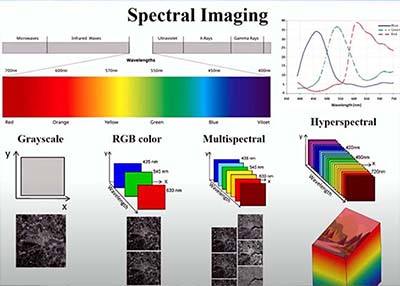
Current air monitoring is minimal, according to Healey, using systems that are limited in time and spatial sampling and rely on manual data collection. However, multispectral and hyperspectral imaging technology — currently being piloted on ALERTCalifornia fire-monitoring video cameras — could fill this void.
“This is the first time that a set of sensors with this spectral coverage has ever been deployed to continuously collect data,” said Healey. “They'll be sending back 1.4 gigabits per second wireless, and we'll be using these to assess air quality. ... The big advantage that this approach has over current approaches is that we get high-quality information over a wide spatial area defined by the full field of view of the sensors continuously.”
These advances have the potential to improve the quality of life in the region by providing insights into which areas to avoid on a certain day and how to control or reduce pollutants.
High-tech facilities
An open house in QI’s Atkinson Hall followed the talks, showcasing the high-tech shared facilities in the building.
“Organizationally and institutionally, what we've done on all three campuses [of CalIT2] is create new facilities, advanced labs that are open to everybody on campus [and] increasingly startups off-campus,” Rao commented. “We’ve also assembled expertise technical folks that partner with faculty, partner with startups, to be able to do new things that you can’t do all by yourself. … This persistent, well-staffed, professionally done infrastructure can be of value to a variety of projects over time.”
Open facilities included:
- The Magnetoencephalography (MEG) Center, which provides an advanced, non-invasive, painless technique for functional brain imaging to researchers, clinicians and patients throughout Southern California;
- The Nano3 (Nanoscience, Nanoengineering, and Nanotechnology) cleanroom, which researchers use for nano/micro-fabrication of electronic and optoelectronic materials and devices, biomedical and biochemical devices, heterogeneous integrated devices and circuits, sensor technology and more;
- The Exercise and Physical Activity Resource Center (EPARC), which offers a fully equipped laboratory to support the research community, train medical students and residents and conduct fitness and performance assessments; EPARC also serves as an independent testing laboratory for the commercial health and fitness sector.
In addition, several start-up companies housed in the QI Innovation Space, including AquilX, Inflammasense, Dimension Genomics and Nadi LLC, presented their work.
For videos of the plenary talks and the lighting talk session on brain imaging, see the CalIT2 Workshop on Health and Research Innovations playlist on the QI’s YouTube Channel. For more information about CalIT2, including upcoming workshops, see the CalIT2 website or the sites of its three divisions, QI (San Diego campus), UCI CalIT2 and UCR CalIT2.
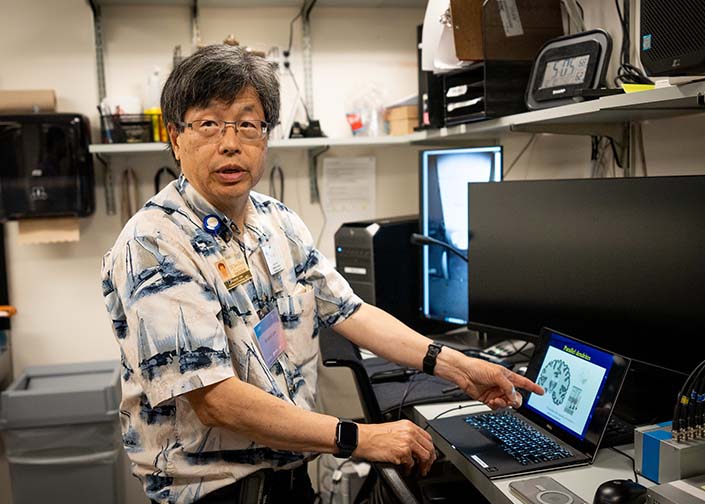
Share This:
You May Also Like
Stay in the Know
Keep up with all the latest from UC San Diego. Subscribe to the newsletter today.




